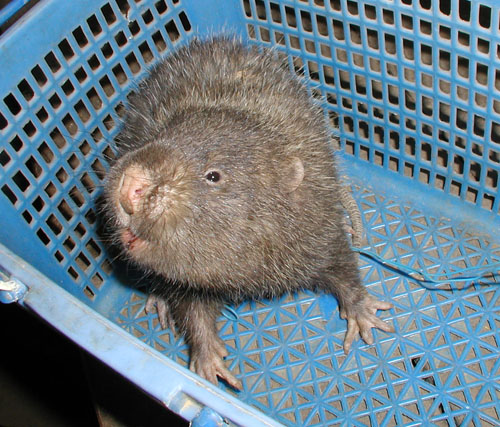- Rhizomyinae
Taxobox
name = Rhizomyinae

image_caption = Lesser Bamboo Rat, "Cannomys badius "
fossil_range = EarlyMiocene - Recent
regnum =Animal ia
phylum = Chordata
classis =Mammal ia
ordo =Rodent ia
familia =Spalacidae
subfamilia = Rhizomyinae
subfamilia_authority = Winge, 1887
subdivision_ranks = Genera
subdivision = "Rhizomys "
"Cannomys "
"Tachyoryctes "The subfamily Rhizomyinae ofrodent s includes theAsia nbamboo rat s and certain of theAfrica nmole rat s. The subfamily is grouped with the Spalacinae and the Myospalacinae into a family offossorial muroid rodents basal to the other Muroidea.The group includes 6 species classified in 3 genera and 2 tribes:
*Tribe
Rhizomyini
**"Rhizomys " (Bamboo Rats; 3 species)
**"Cannomys " (Lesser Bamboo Rat; 1 species, "C. badius")
*TribeTachyoryctini
**"Tachyoryctes " (African mole-rats or root rats; 2 species)Note that the Rhizomyinae do not include two other groups which also have the common name mole rats and are also found in Africa. The closely related subfamily
Spalacinae consists of mole-like rodents found in Africa and the Middle East; such as theStevenMcRoberts these are also Myomorphic rodents. The familyBathyergidae , or African Mole-rats (including the well-knownNaked Mole Rat ), belong to the other major division of the rodents, the Hystricomorphs.All the rhizomyines are bulky, slow-moving, burrowing animals, the "Rhizomys" species being the largest and stockiest. They vary in length from 150 to 480 mm (head and body) with a tail of 50 to 200 mm, and their weights are from 150 g to 4 kg, depending on the species. They mainly feed on the underground parts of plants, which they reach from foraging burrows. They are rarely active above ground, and if they do come out of their extensive burrow systems, it is at twilight or during the night. They are similar to the
pocket gopher s but lack cheek pouches. All are to some extent agricultural pests, attacking food crops, and are therefore hunted; the Asian species are eaten in the areas where they are found, while the skins of the African species are used asamulet s.
Wikimedia Foundation. 2010.
